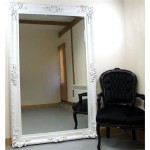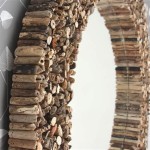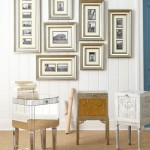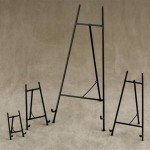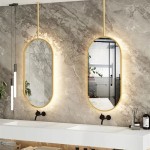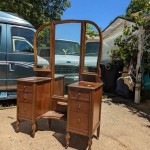French Trumeau Mirrors: An Enduring Legacy of Elegance
French Trumeau mirrors represent a distinct and captivating category of decorative art. These meticulously crafted pieces transcend mere functionality, serving as focal points that embody the refined aesthetic of French design. Originating in the 18th century, trumeau mirrors offer a glimpse into the opulence and artistic sensibilities prevalent during the reigns of Louis XV and Louis XVI, continuing to be sought after by collectors and interior designers today.
The term "trumeau" itself refers to the section of wall between two windows, or more generally, any wall panel. A trumeau mirror, therefore, is a mirror designed to be incorporated into such a panel, often forming an integral part of the room's architecture and decorative scheme.
The evolution of the trumeau mirror is closely linked to the architectural trends of the time. As rooms grew larger and ceilings higher, the need for decorative elements that could visually expand the space and enhance the sense of grandeur became apparent. Trumeau mirrors, with their reflective surfaces and ornate embellishments, perfectly addressed this need.
Beyond their aesthetic appeal, French trumeau mirrors provide valuable insight into the social and economic context of their creation. The materials used, the craftsmanship displayed, and the motifs incorporated into the design all reflect the tastes and values of the era. Studying these mirrors offers a tangible connection to the past, allowing one to appreciate the artistry and ingenuity of the artisans who created them.
Understanding the Key Characteristics of French Trumeau Mirrors
Several defining characteristics distinguish French trumeau mirrors from other types of mirrors. Understanding these features is crucial for identifying authentic pieces and appreciating their unique qualities.
Firstly, the construction of a trumeau mirror typically involves a combination of materials, including wood, plaster, gesso, and glass. The frame is usually made of wood, often oak or pine, which provides a solid foundation for the decorative elements. Gesso, a white coating made from plaster of Paris and glue, is then applied to the wood surface to create a smooth, even base for painting and gilding. The mirror itself is usually made of hand-blown glass, which often exhibits slight imperfections and variations that add to its character.
Secondly, the decorative motifs found on French trumeau mirrors are highly symbolic and reflect the artistic trends of the period. Common motifs include floral arrangements, musical instruments, pastoral scenes, mythological figures, and architectural elements. These motifs are often executed in intricate detail, showcasing the skill and artistry of the craftsmen involved. The use of gold leaf, or gilding, is another hallmark of trumeau mirrors, adding a touch of luxury and elegance to the design.
Thirdly, the painted finish of a trumeau mirror is an integral part of its overall aesthetic. The color palettes typically employed are soft and muted, reflecting the pastel hues popular in 18th-century France. Common colors include ivory, cream, pale blue, soft pink, and delicate green. The paint is often applied in layers, creating a subtle depth and texture. Distressing techniques, such as chipping and cracking, are also sometimes used to give the mirror an aged and antique appearance.
The shape and size of trumeau mirrors can vary considerably, depending on their intended location and the architectural style of the room. Some mirrors are tall and narrow, designed to fill the space between windows, while others are shorter and wider, intended to be placed above a fireplace or console table. The frame may be rectangular, oval, or even shaped to incorporate decorative elements such as scrolls and cartouches.
The Significance of Decorative Motifs
The decorative motifs adorning French trumeau mirrors are not merely ornamental; they carry symbolic meanings that reflect the values and beliefs of the era. Examining these motifs provides valuable insight into the cultural context in which the mirrors were created.
Floral motifs, for example, are ubiquitous in trumeau mirror design. Roses symbolize love and beauty, lilies represent purity and innocence, and laurel wreaths signify victory and honor. The specific types of flowers used and the way they are arranged can convey different messages and emotions. A garland of roses, for instance, might be used to celebrate a marriage, while a single lily could represent mourning and remembrance.
Musical instruments, such as harps, lutes, and flutes, are another common motif. These instruments symbolize harmony, creativity, and the pursuit of pleasure. The inclusion of musical instruments in trumeau mirror design reflects the importance of music and the arts in 18th-century French society. Many aristocrats were accomplished musicians themselves, and music played a central role in social gatherings and entertainment.
Pastoral scenes, depicting idyllic landscapes with shepherds, shepherdesses, and grazing animals, evoke a sense of tranquility and simplicity. These scenes reflect a romanticized view of rural life, a popular theme in 18th-century art and literature. Pastoral motifs often symbolize peace, contentment, and a connection to nature.
Mythological figures, such as Cupid, Venus, and Apollo, are also frequently incorporated into trumeau mirror design. These figures represent love, beauty, and artistic inspiration, respectively. The use of mythological imagery reflects the enduring influence of classical art and literature on French culture. Many aristocrats were well-versed in mythology and appreciated the allegorical meanings conveyed by these figures.
Architectural elements, such as columns, pilasters, and pediments, are often used to frame the mirror and create a sense of grandeur. These elements evoke the classical architecture of ancient Greece and Rome, reflecting the admiration for these civilizations during the neoclassical period. The inclusion of architectural elements in trumeau mirror design reinforces the idea that these mirrors are not just decorative objects but also integral parts of the room's architectural framework.
Identifying and Authenticating French Trumeau Mirrors
Given the enduring popularity of French trumeau mirrors, reproductions and imitations are abundant. Therefore, it is essential to be able to distinguish authentic antique pieces from more recent creations. Several factors can help in identifying and authenticating a French trumeau mirror.
First, examine the construction and materials. Authentic trumeau mirrors are typically made using traditional techniques and materials, such as hand-carved wood, gesso, and hand-blown glass. The presence of these materials and techniques is a strong indication of authenticity. Conversely, the use of modern materials and manufacturing processes, such as MDF, plastic, and machine-made glass, is a red flag.
Second, assess the quality of the craftsmanship. Authentic trumeau mirrors exhibit a high level of skill and attention to detail. The carvings are intricate and precise, the gilding is expertly applied, and the paint finish is smooth and even. Look for telltale signs of hand craftsmanship, such as slight imperfections and variations. Reproductions, on the other hand, often lack the finesse and artistry of antique pieces.
Third, consider the age and patina of the mirror. Authentic trumeau mirrors will typically show signs of age, such as wear and tear, cracks, and discoloration. The patina, or surface appearance, of the mirror will also reflect its age and history. However, it is important to note that some unscrupulous dealers may artificially age reproductions to make them appear more authentic. Therefore, it is crucial to carefully examine the patina and compare it to other known examples of antique trumeau mirrors.
Fourth, research the maker and provenance of the mirror. If possible, try to identify the maker or workshop that created the mirror. Some antique trumeau mirrors bear marks or signatures that can help in this process. Additionally, research the provenance, or history of ownership, of the mirror. A well-documented provenance can add considerable value and credibility to a piece.
Finally, consult with an expert. If you are unsure about the authenticity of a French trumeau mirror, it is always best to seek the advice of a qualified antique dealer or appraiser. These professionals have the knowledge and experience to accurately assess the age, quality, and value of antique furniture and decorative arts.
In conclusion, French trumeau mirrors represent a remarkable blend of artistry, craftsmanship, and history. These elegant pieces offer a glimpse into the opulence and refinement of 18th-century French design, continuing to be cherished by collectors and enthusiasts around the world. Understanding the key characteristics, decorative motifs, and authentication methods associated with trumeau mirrors is essential for appreciating their enduring legacy.

How To Create A French Trumeau Mirror Edith Evelyn

How To Create A French Trumeau Mirror Edith Evelyn

French Trumeau Mirror Louis Xvi Antic Denmark

French Empire Style Trumeau Mirror Early 20th C

Louis Xvi Style Painted And Gilded French Trumeau Mirror

Maison Decor How To Make A French Trumeau Mirror

Trumeau Mirror Rf Architectural Garden Antiques

Decorating With French Trumeau Mirrors Mirror Antique Frame

Pair Or Single French Trumeau Mirrors Mirror Classic

How To Create A French Trumeau Mirror Edith Evelyn
